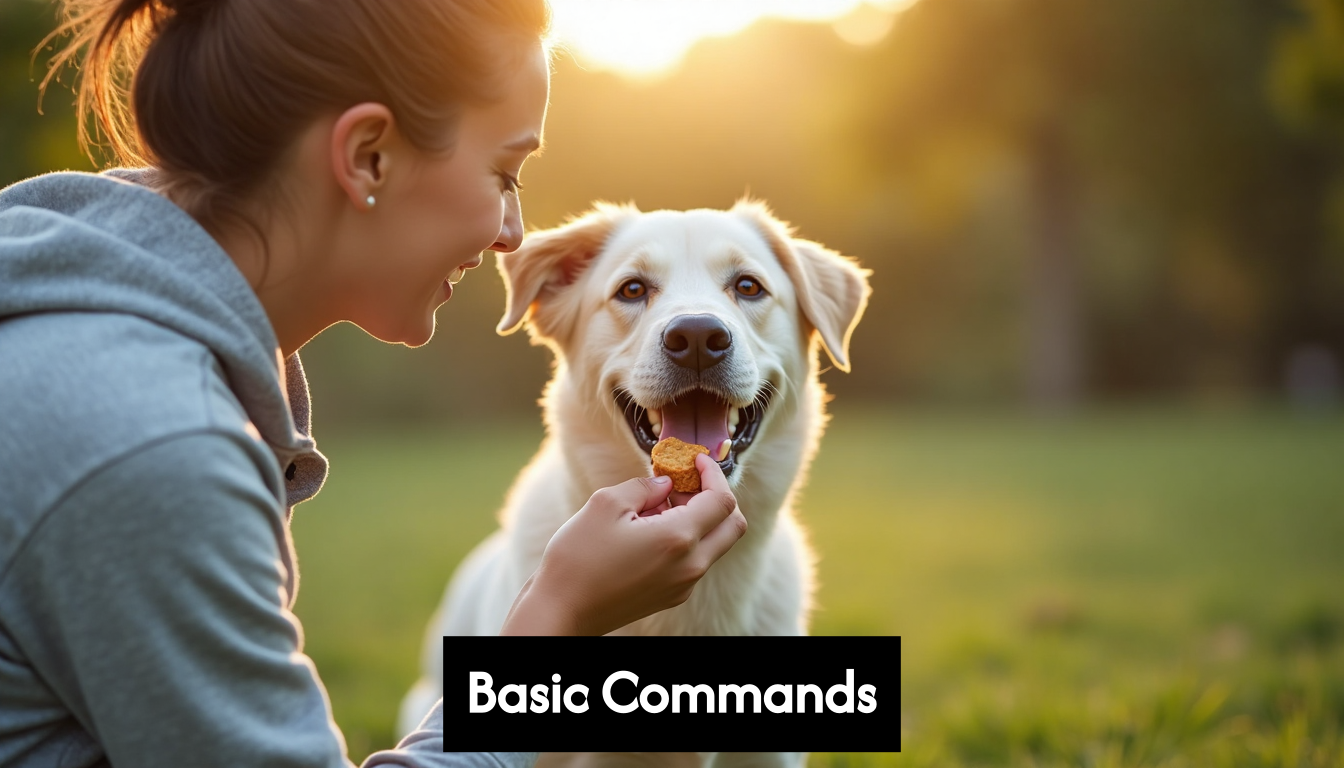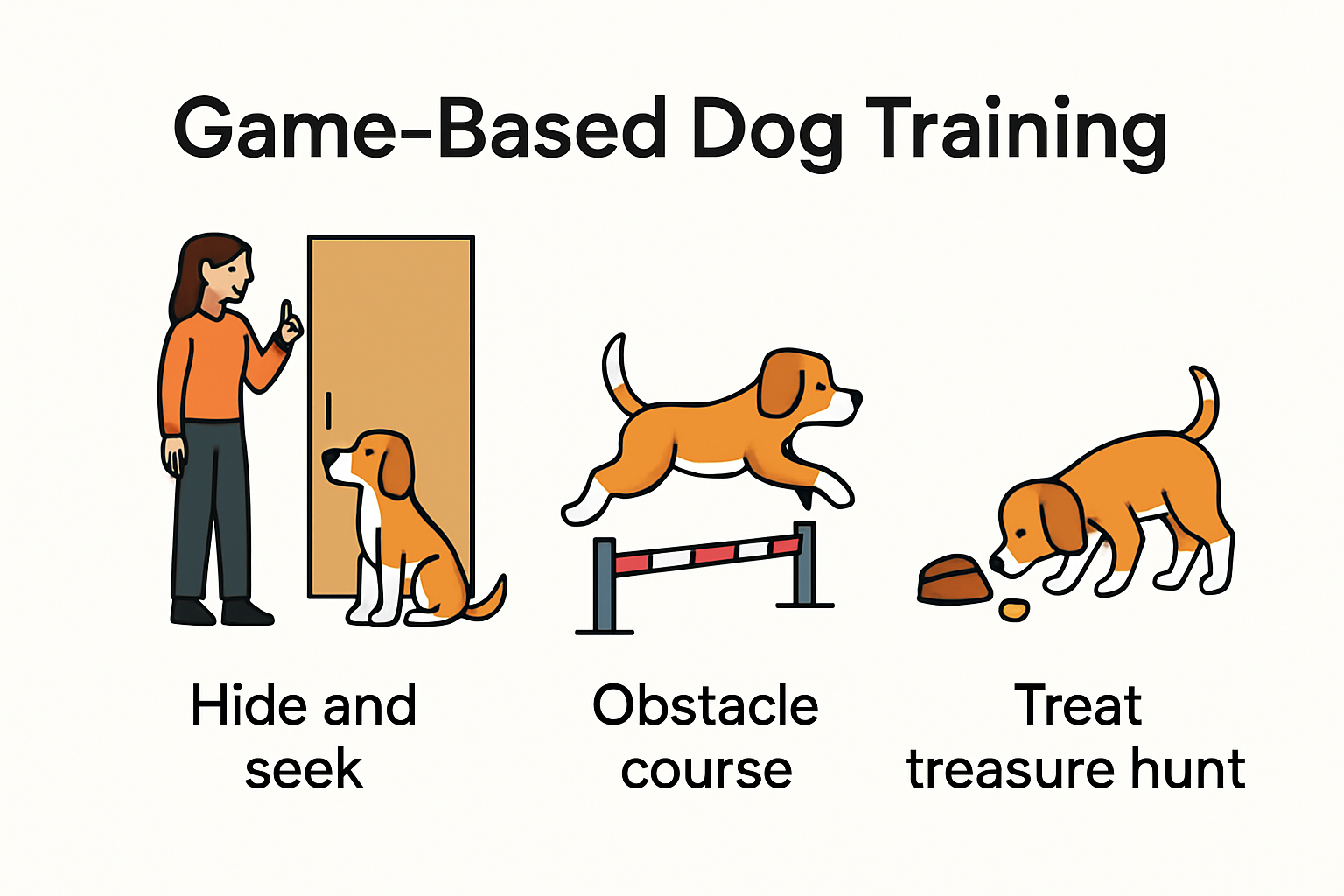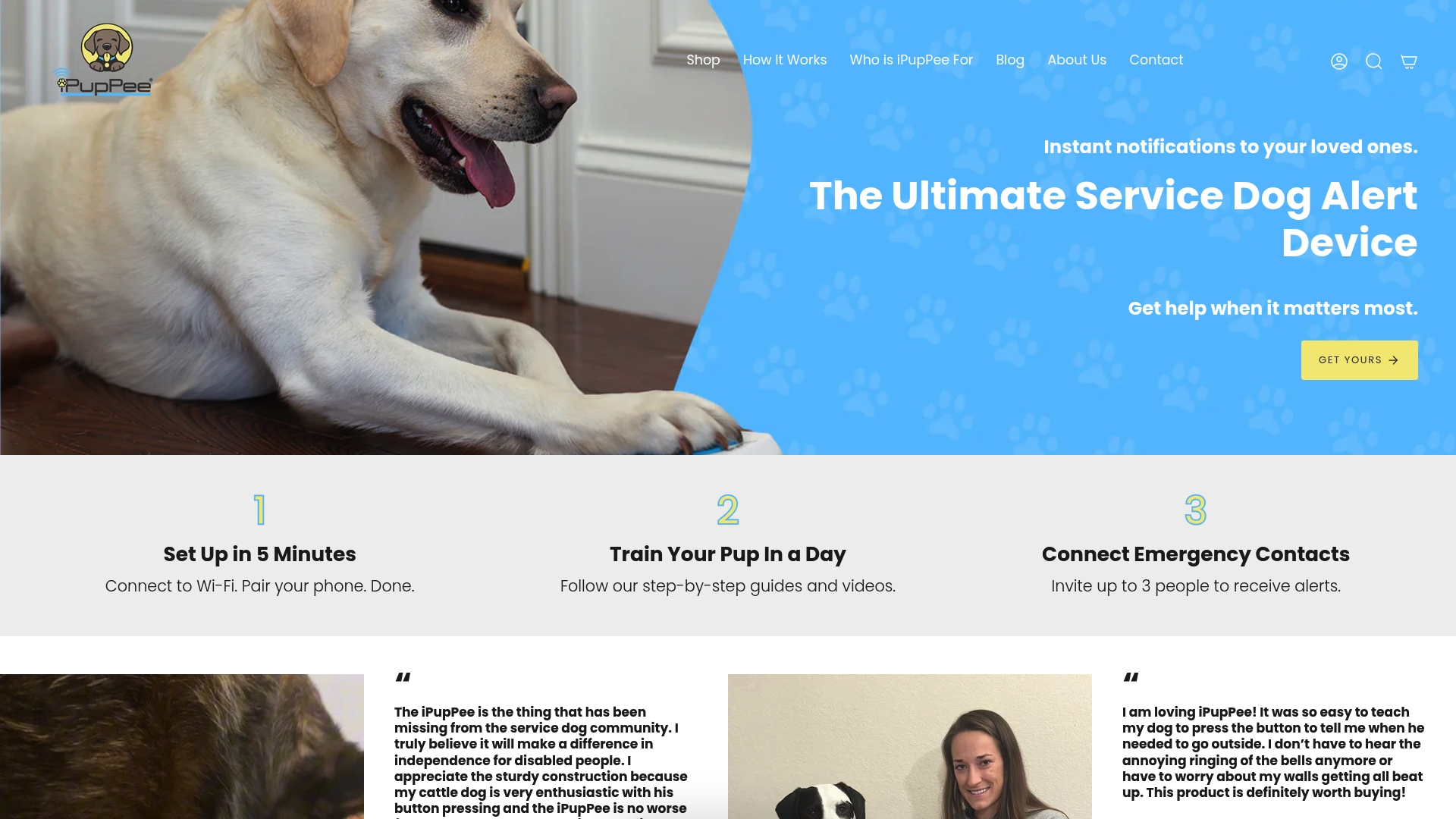
Teaching your dog basic commands in 2025 is more than just a necessity for obedience; it’s a chance to deepen your bond with your furry friend. Studies show that using positive reinforcement can improve learning outcomes by nearly 80 percent. But here’s the twist: simply tossing treats won’t cut it anymore. The future of dog training emphasizes creativity and fun. Instead of traditional methods, imagine engaging your dog with games that keep them excited and eager to learn. This approach transforms training into an adventure rather than a chore.
Table of Contents
- Essential Foundation For Dog Learning
- Teaching Key Basic Dog Commands
- Dealing With Common Training Issues
- Making Dog Training Fun And Rewarding
Quick Summary
| Takeaway | Explanation |
|---|---|
| Consistency in Communication | Use clear, repetitive verbal and non-verbal signals to establish effective dog training. This clarity facilitates understanding and enhances learning. |
| Positive Reinforcement | Reward desired behaviors immediately to motivate your dog and reinforce learning. High-value treats and verbal praise can significantly improve retention and performance. |
| Game-Based Learning | Incorporate play into training sessions, such as hide and seek or obstacle courses, to keep your dog engaged and motivated while learning commands. |
| Address Behavioral Challenges | Identify underlying causes of issues like excessive barking or leash pulling, and apply strategic interventions, such as positive redirection and desensitization, to address them effectively. |
| Create a Positive Atmosphere | Ensure a calm, engaging training environment by respecting your dog’s mood and energy levels, which helps turn training into a fun experience for both you and your dog. |
Essential Foundation for Dog Learning
Successful dog training requires understanding fundamental learning principles that create a solid groundwork for communication and behavioral development. The journey of teaching dogs begins with recognizing their unique cognitive processes and establishing trust through strategic, positive interactions.
Psychological Principles of Canine Learning
Dogs learn through a combination of associative and observational mechanisms that differ significantly from human learning patterns. Their cognitive process relies heavily on immediate reinforcement and clear, consistent communication. According to Virginia Tech’s Animal Behavior Research Center, positive reinforcement strategies dramatically enhance learning performance, with dogs showing increased motivation and reduced stress when training approaches prioritize reward over punishment.
The brain of a dog processes information through associative learning, where they connect specific actions with consequences. This means every interaction becomes a potential teaching moment. When you consistently reward desired behaviors with treats, praise, or play, you’re essentially creating neurological pathways that encourage those behaviors to be repeated.
Establishing Foundational Training Frameworks
Building a comprehensive training framework requires understanding core learning stages. Effective dog training fundamentals involve several critical components:
- Consistent Communication: Using clear, repetitive verbal and non-verbal signals
- Positive Reinforcement: Rewarding desired behaviors immediately
- Incremental Skill Building: Gradually increasing complexity of commands
Research from Aberystwyth University’s Canine Cognition Lab suggests that incorporating scent-based activities can significantly enhance a dog’s impulse control and cognitive development. This approach not only makes training more engaging but also stimulates their natural problem-solving instincts.
Environmental and Emotional Considerations
Training success depends equally on understanding a dog’s emotional state and creating an optimal learning environment. Stress, anxiety, and previous experiences dramatically influence a dog’s ability to learn and retain new information. Professional trainers emphasize creating a calm, predictable training atmosphere where dogs feel secure and motivated.
Key environmental factors include:
- Minimal distractions
- Consistent training location
- Appropriate time of day
- Matching training intensity to the dog’s energy level
By recognizing that each dog is an individual with unique learning capabilities, owners can develop personalized training strategies that respect their pet’s psychological and emotional needs. The goal isn’t just obedience, but building a trusting, communicative relationship that allows both dog and human to understand and respect each other’s boundaries and capabilities.
Remember, teaching dogs is a journey of patience, understanding, and mutual respect. Every interaction is an opportunity to strengthen your bond and enhance their learning potential.
Teaching Key Basic Dog Commands
Teaching fundamental commands is crucial for establishing communication, ensuring safety, and developing a strong bond with your dog. The process requires patience, consistency, and a strategic approach that makes learning enjoyable and rewarding for both you and your canine companion.
Strategic Command Learning Approach
Modern dog training emphasizes an intermixed learning strategy that challenges traditional sequential training methods. According to University of Lincoln’s Canine Behavior Research, dogs learn more effectively when commands are integrated within a single training session rather than taught in strict isolation.
The most critical basic commands every dog should master include:
- Sit: Foundation for impulse control
- Stay: Essential for safety and situational management
- Come: Critical for recall and preventing dangerous scenarios
- Leave it: Protects dogs from potential hazards
- Heel: Ensures controlled walking and social interactions
Successful command training requires breaking down each instruction into small, manageable steps. For instance, teaching “sit” involves creating a positive association with the action, using treats as immediate rewards, and maintaining a calm, encouraging environment.
Positive Reinforcement Techniques
Canine Social Research Institute studies confirm that reward-based training dramatically improves command learning speed and retention. Dogs trained through positive reinforcement not only learn faster but also develop stronger emotional connections with their owners.
Key positive reinforcement strategies include:
- Using high-value treats during initial training
- Providing immediate verbal praise
- Maintaining short, engaging training sessions
- Varying reward types to maintain interest
- Gradually reducing treat frequency as commands become consistent
Avoiding Common Training Pitfalls
Effective command training requires understanding and avoiding potential obstacles. Behavioral Research on Canine Learning highlights that punishment-based methods can create anxiety and reduce learning efficiency.
Common mistakes to avoid include:
- Inconsistent command language
- Training when the dog is overly tired or distracted
- Expecting perfection too quickly
- Using complex or multiple-word commands
- Failing to practice commands in various environments
Consistent practice across different settings helps dogs generalize commands. A command learned in your living room must be reliable in a park, on a street, or around other distractions. This generalization ensures that your dog responds reliably in any situation.
Remember, every dog learns differently. Some may grasp commands quickly, while others require more time and patience. The key is maintaining a positive, supportive approach that makes learning an enjoyable experience for your furry companion.
Dealing with Common Training Issues

Training dogs is rarely a linear process, and encountering challenges is a normal part of developing a well-behaved companion. Understanding how to navigate and resolve these issues effectively can transform potential frustrations into opportunities for strengthening your relationship with your dog.
Identifying Behavioral Roadblocks
Behavioral challenges emerge from various sources, including past experiences, breed characteristics, and individual personality traits. Virginia Tech’s Animal Behavior Research Center emphasizes that using frustration-based training methods can significantly impede learning progress and damage the dog-owner relationship.
Common training issues dog owners frequently encounter include:
- Excessive Barking: Often a sign of anxiety or attention-seeking
- Jumping: Typically a social excitement response
- Pulling on Leash: Indicates lack of impulse control
- Inconsistent Command Response: Suggests insufficient reinforcement
- Reactive Behavior: Can stem from fear or lack of socialization
Successful resolution requires a systematic approach that addresses the underlying cause rather than just the symptom. This means understanding your dog’s emotional state and motivation behind the behavior.
Strategic Intervention Techniques
University of Lincoln’s Canine Research Team recommends a nuanced approach to addressing training challenges. Their research highlights the importance of targeted intervention strategies that focus on positive redirection and consistent reinforcement.
Effective intervention techniques include:
- Identifying trigger points for problematic behaviors
- Creating alternative behavior patterns
- Using marker training to redirect attention
- Implementing gradual desensitization methods
- Maintaining calm, consistent energy during training
Marker training, as demonstrated in Frontiers in Veterinary Science, provides a precise communication method that helps dogs understand exactly which behaviors are desirable.
Developing Long-Term Behavioral Solutions
Addressing training issues isn’t about quick fixes but creating sustainable behavioral patterns. This requires patience, consistency, and a deep understanding of canine psychology. Professional dog trainers recommend developing a comprehensive approach that considers the dog’s individual needs, environmental factors, and emotional state.
Key strategies for long-term success include:
- Regular training sessions
- Gradual skill progression
- Positive reinforcement
- Consistent boundary setting
- Adapting techniques to individual dog personalities
Remember that every dog is unique. What works for one might not work for another. The most successful training approach combines scientific understanding with compassionate, individualized attention. Challenges are not roadblocks but opportunities to deepen your understanding and connection with your canine companion.
Ultimately, successful dog training is about building trust, communication, and mutual respect. Approach each challenge as a chance to learn and grow together, transforming potential frustrations into moments of shared understanding and connection.
Making Dog Training Fun and Rewarding
Transforming dog training from a potentially tedious task into an enjoyable, engaging experience is crucial for long-term learning success. The key lies in creating an environment where both dog and owner look forward to training sessions, turning them into opportunities for bonding and mutual enjoyment.
Game-Based Learning Strategies
 University of Lincoln’s Canine Research Team has demonstrated that incorporating play-based approaches dramatically increases dogs’ motivation and learning outcomes. Game-based training leverages a dog’s natural instincts and playful energy, making learning feel less like work and more like an exciting activity.
University of Lincoln’s Canine Research Team has demonstrated that incorporating play-based approaches dramatically increases dogs’ motivation and learning outcomes. Game-based training leverages a dog’s natural instincts and playful energy, making learning feel less like work and more like an exciting activity.
Innovative game-based training techniques include:
- Hide and Seek Commands: Combining recall with an exciting search game
- Obstacle Course Training: Creating fun challenges that teach multiple skills
- Treat Treasure Hunt: Integrating command learning with scent work
- Interactive Puzzle Toys: Developing problem-solving skills through play
- Role-Reversal Games: Allowing dogs to “teach” commands back to owners
These approaches transform training from a rigid process into a dynamic, interactive experience that keeps dogs mentally stimulated and emotionally engaged.
Maximizing Reward Effectiveness
According to Virginia Tech’s Animal Behavior Research Center, the key to preventing training frustration is creating a positive, low-stress learning environment. Marker training emerges as a powerful technique, providing immediate positive feedback that dogs can clearly understand.
Effective reward strategies include:
- Varying reward types (treats, toys, praise, play)
- Using high-value treats for challenging tasks
- Maintaining unpredictability in reward delivery
- Matching rewards to the dog’s individual preferences
- Gradually reducing treat frequency while maintaining enthusiasm
Frontiers in Veterinary Science highlights that the most successful training approaches link immediate positive feedback with high-reward experiences, creating a powerful learning motivation.
Creating a Positive Training Atmosphere
Beyond specific techniques, the overall training atmosphere plays a critical role in making learning enjoyable. This involves understanding your dog’s unique personality, energy levels, and emotional state. Some dogs may prefer short, intense training bursts, while others thrive on longer, more relaxed sessions.
Key elements of a positive training environment include:
- Choosing optimal training times
- Reading and respecting your dog’s mood
- Keeping sessions short and engaging
- Maintaining a calm, enthusiastic demeanor
- Celebrating small victories
- Avoiding frustration or negative emotions
The ultimate goal is to make training feel like a collaborative adventure. When dogs perceive training as a fun, rewarding experience shared with their favorite human, they become more eager to learn and more responsive to instructions.
Remember, every dog is an individual. What works for one might not work for another. The most successful trainers remain flexible, creative, and attuned to their dog’s unique learning style, turning each training session into an opportunity for joy, connection, and mutual growth.
Frequently Asked Questions
How can I teach my dog the basic commands in 2025?
To teach your dog basic commands, use a strategic approach that combines positive reinforcement, consistency, and engaging techniques like games. Start with fundamental commands like ‘Sit,’ ‘Stay,’ and ‘Come,’ breaking each command into manageable steps.
What is the most effective method for dog training in 2025?
The most effective method for dog training in 2025 involves positive reinforcement techniques, where you reward desired behaviors immediately to motivate your dog. Incorporating game-based learning can also keep training fun and engaging.
What should I do if my dog doesn’t respond to commands?
If your dog isn’t responding to commands, check for distractions in the environment, ensure consistency in your command language, and use high-value rewards. Consider also adapting training techniques to better fit your dog’s unique personality and energy levels.
How long should my dog training sessions be?
Training sessions should be kept short and engaging, typically around 5 to 15 minutes. This helps maintain your dog’s focus and prevents them from becoming bored or stressed, making learning more effective.
Elevate Your Dog Training Experience with iPupPee!
Imagine a world where your dog not only understands basic commands like ‘Sit’ and ‘Stay,’ but also communicates their needs effectively. As highlighted in our article, teaching your dog basic commands is essential for building a strong bond and ensuring their safety. However, even with the best training techniques, communication gaps can arise—especially for service dogs or pets helping those with special needs. This is where iPupPee steps in, bridging the communication divide between you and your furry companion.

With our innovative iPupPee alert device, you can enhance your training sessions and foster seamless communication. Picture this: your dog presses a button to signal a need or command, making them feel more empowered while you ensure their safety and independence.
-
Key benefits of the iPupPee:
- Enables effective communication through a simple button press
- Works seamlessly alongside traditional command training methods
- Ideal for service dog handlers, new puppy owners, and anyone prioritizing safety
Don’t wait for training frustrations to pile up—act now! Visit https://ipuppee.com and explore how the iPupPee can transform your dog’s learning journey today!

